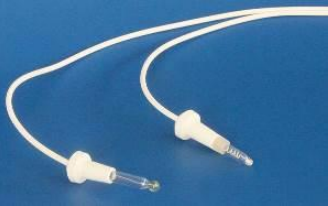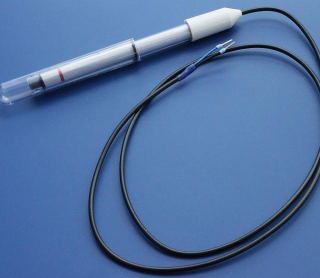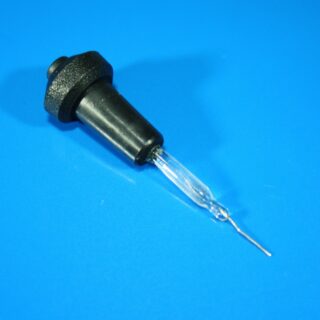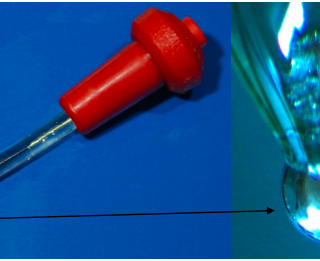Category
- Custom made glass products
- CUSTOMER SERVICES
- NEW PRODUCTS
- Sensors and electrodes
- Custom made and Modified Screen Printed Electrodes
- Stirrers
- Cables and connectors
- Cell
- Potentiostats
- Manual Screen Printer
- Minithermostat
- Pumps
- Accessories
- Kits & Sets
- Discounted SPEs (at a reduced price with visual defects/inconsistancies, but fully functional)
pH Electrode Conic
pHc Electrode are used as sensors for potentiometric determination of H+, respective H3O+ activity, expressed in pH units.
Conic electrodes are applicable to all commonly used measuring apparatus with inner resistance of 10^9 ohm or more.
Electrode is designed for measurements with TC4, TC5 and TC6 glass cell.
Useful Documents
You may also like…
-
ISE Ion Selective Electrodes
Read moreIon Selective Electrodes, ISEs, are analytical tools widely used for potentiometric analysis of large scale of various ionic analytes.
ISEs enable routine analysis in agriculture, food process, soil analysis, environmental anylysis, tribotechnical analysis, explosives and pyrotechnical mixtures analysis. They can be used for water, pot-, waste-, boiler-, mineral-, and well water samples.
These electrodes allow for direct measurements of Ammonium, Lithium, Sodium, Calcium, Fluoride, Nitrate, Potassium and Barium.
Electrodes are applicable to all commonly used measuring apparatus, with internal resistance of above 10^9 – 10^12 ohm.
Diameter: 12 mm.
Standard electrical connecting cable is 0.8 to 1 m. coaxial cable with BNC connector.
The work with ion selective electrodes is time effective, requires an only small amount of chemicals, and a friendly price of measuring equipment MPH472.
-
MPH 472 Universal Potentiostat
Read moreThe instrument enables measurement of amperometry, potentiometry and conductometry. Communication with the computer is provided via USB or Bluetooth. This hand-held device is equipped with GPS navigation so the measured data may be enhanced by the exact coordinates of the location where the measurement was made.
Measured data can be stored and later processed in a PC because of the SD card slot incorporation. The ability to record a waveforms or integrate the measure values is enabled. Basic evaluation methods are also implemented – linear and non-linear calibration and standard addition method is available. The influence of the type of oxygen electrode membrane, temperature or gas solubility can be compensated for the measured values.
The measured data are automatically recalculated and displayed in units of current, voltage, concentration (g∙L-1 or mol∙L-1) or saturation. Potentiometric measurement allows connection of pH electrodes and ISE.
Key Properties
- Up to 200 hours of battery life depending on the operating mode.
- Excellent analytical tools (graphs, unit conversions, internal standard method for potentiometry, coulometric titration, 10 Henry’s constants for various redox active gases).
- Power supply and data communication via USB, possibility of connection via Bluetooth.
- Data logging to memory card.
- Up to 5-point calibration for ISE and pH electrodes.
- Up to 4-point calibration of the conductivity cell makes it possible to compensate the non-linearity of the measurement.
- GPS equipment enables measurements in the field with location storage.
- Calibration stored separately in the device (possibility of changing the memory card without having to recalibrate the device).
- Possibility of separate calibration for 4 probes for amperometry and potentiometry.
- The possibility of using different temperature sensors (PT100, PT1000, Ni1000, ATC Monocrystals).
- Advanced power management (display sleep and automatic device shutdown can be set according to the user’s preferences
- Vector voltmeter for accurate conductivity measurement.
- Powerful thirty-two-bit microprocessor for accurate measurement calculations.
Improvements:
- Faster battery charging via USB charger.
- Vector voltmeter for precise conductometric measurement.
- A more sensitive GPS module.
- More robust input circuits for ametrometric measurement – less susceptible to noise.
More information can be found through the link: https://www.monokrystaly.cz/cs/ph-mv-ion-metry.html?fbclid=IwAR3ieir-mH-D10LZ-SZkrx74OHZYvOHjZPnOX8nfi9WdcwostsUgTAVaZPM#MPH471
Related products
-
OE.D*.E** Oxygen Electrode
Read moreThe Oxygen electrode consists of a PEEK body, platinum electrode, silver reference electrode and membrane holder.
The platinum electrode is melted in glass. The membrane holder with electrolyte is attached by thread. Oxygen electrode (OE) is designed for measurements with thermostated cell TC4, TC5, TC6.
-
WCEc.W*.D* Working Classic Electrode Conic
Read moreWCEc is a glass tube with a Pt or Au (wire) or a peek tube with a compact glassy carbon inside.
Only the circle glossy area of the (Pt or Au) metal wire is outside the glass tube or the circular glossy area of compact glassy carbon is outside the plastic peek tube. Standard connection is with a 2 mm banana connector. Connector or banana plug colour is red. Working classic electrode (WCEc) is designed for measurements with TC4, TC5, TC6, TC9 glass cell.
-
Hanging Platinum Drop Electrode
Read moreThe Hanging Platinum Drop Electrode (HPDE) is solid phase alanogy of HMDE.
The drop of liquid Pt at 2000 °C forms a drop of Pt. The surface of HPDE has nearly ideal surface which is impossible to obtain using polishing. HPDE has also spherical symmetry which enables mathematical treatment of its response.
The material is not toxic and it is chemically stable. The only disadvantage is HPDE cleaning, which can be, however, in some cases solved by carefull insertion of the electrode tip to the flame of an alcohol burner.
Thus HPDE can be used as reference electrode for complicated electrochemical studies, where it is necessary to distinguish the analytical signal from the signal generated by surface inhomogenities.Hanging platinum drop electrode (HPDE) is designed for measurements with thermostated cell TC4, TC5, TC6 and TC9.







